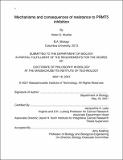Mechanisms and consequences of resistance to PRMT5 Inhibition
Author(s)
Mueller, Helen S.
DownloadThesis PDF (17.37Mb)
Advisor
Lees, Jacqueline A.
Terms of use
Metadata
Show full item recordAbstract
Drug resistance to cancer therapies poses a major clinical challenge and is a key obstacle to successful cancer treatment. Understanding how resistance develops and whether resistance brings new vulnerabilities, or collateral sensitivities, to secondary therapies is essential to combating drug resistance. Epigenetic regulators are being increasingly linked to cancer, resulting in the development of inhibitors against them and testing the inhibitors as effective cancer therapies. Some have entered the clinic, and many are in clinical trials, however, for many, little is known about mechanisms of resistance. One such epigenetic regulator, protein arginine methyltransferase 5 (PRMT5), is highly expressed in many tumor types and PRMT5 inhibitors are currently in early phase clinical trials.
In this dissertation, we have generated the first model of resistance to PRMT5 inhibitors. In Kras-G12D;p53-null lung adenocarcinoma cell lines, resistance arose rapidly, and stemmed from a drug-induced transcriptional state switch, not from the selection of a pre-existing population. This resistant state was stable and brought with it vulnerabilities to other chemotherapeutics, especially the taxane paclitaxel. We found that this taxane sensitivity required stathmin 2 (STMN2), a microtubule regulator that is specifically expressed in the resistant state. Remarkably, Stmn2 was also required for the establishment and maintenance of resistance to PRMT5 inhibition. Analysis of TCGA patient data showed that high STMN2 levels correlate with complete regression of tumors in response to taxane treatment. Thus, identification of collateral sensitivities yields insight into resistance mechanisms and uncovers ways to optimize treatment strategies. The results we present here may offer solutions to combat the emergence of resistance and impact the future development of using PRMT5 inhibitors as in combination with other therapies.
Date issued
2021-06Department
Massachusetts Institute of Technology. Department of BiologyPublisher
Massachusetts Institute of Technology